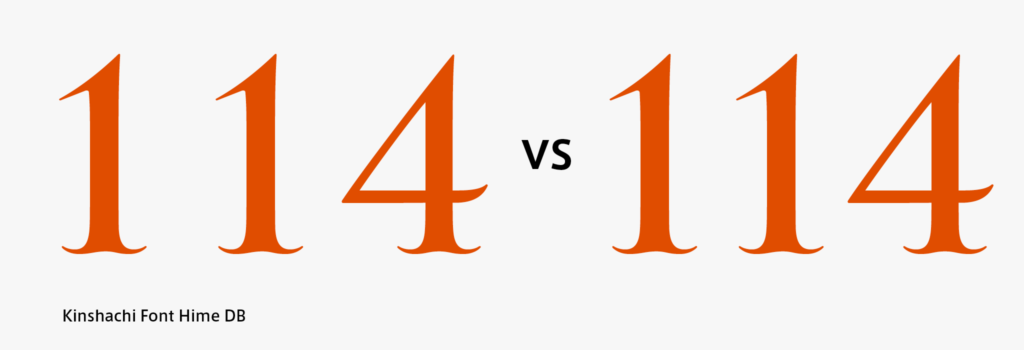When we talk about the figures included in fonts, the terms: “proportional” or “tabular” tend to be slightly complicated.
Apart from the default figures “0123456789,” full-width figures “0123456789” are included in general Japanese fonts. On the other hand, proportional figures and tabular figures are frequently included in Latin fonts.
The default figures in Japanese fonts may be called “proportional figures” (to distinguish them from full-width figures). However, the default figures in Japanese fonts are often tabular figures in accordance with terminology used for Latin fonts in most cases. Therefore, all character widths, from 0 to 9, are designed in the same way (so as to be arranged vertically when set in tabular composition).
For that reason, to avoid confusion, with the use of the feature tags in the OpenType fonts, tabular figures in the terminology of Latin fonts are written as tnum, and proportional figures are written as pnum.

The figure shows Kinsachi Font Hime. The default figures (tnum) are on the left, and proportional figures (pnum) are on the right. Japanese fonts do not include pnum in many cases, but Kishachi Font Hime has both tnum and pnum.
The story of figures continues in the next article: “Lining Numbers and Old Style Numbers (lnum/onum).
(mm)
Series archive Typesetting Japanese / Font Typesetting Function
- Font Typesetting Function 17: “Lining Numbers and Old Style Numbers (lnum/onum)”
- Font Typesetting Function 16: “Tabular Figures and Proportional Figures (tnum/pnum)”
- Font Typesetting Function 15: “Expert Forms (expt)”
- Font Typesetting Function 14: “Discretionary Ligature (dlig) Part 2”
- Font Typesetting Function 13: “Discretionary Ligature (dlig)”
- Font Typesetting Function 12: “Latin Ligature (liga)”
- Font Typesetting Function 11: “JIS78 Character Shape (jp78)”
- Font Typesetting Function 10: “Group of Fraction (afrc/frac)”
- Font Typesetting Function 09: “JIS90 Character Shape (jp90)”
- Font Typesetting Function 08: “Metrics Kerning”
- Font Typesetting Function 07: “Various Things About Kerning”
- Font Typesetting Function 06: “Proportional Metrics”
- Font Typesetting Function 05: “[Narrowed Spacing Between Characters] in Adobe Applications”
- Font Typesetting Function 04: “Which Function for Narrowed Spacing Between Characters is Used?”
- Font Typesetting Function 03: “Mechanism of Typesetting with Narrowed Spacing Between Characters”
- Font Typesetting Function 02: “GPOS and GSUB”
- Font Typesetting Function 01: “What are the OpenType Features?”